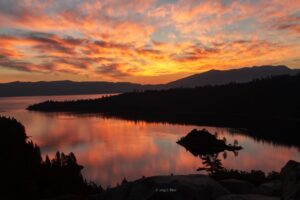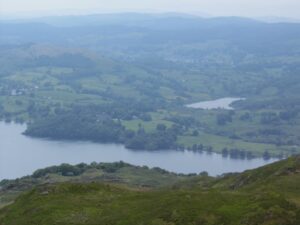Stratification phenology plays a major role in driving lifecycle events in lakes. Subtle changes in stratification onset and break-up can determine the availability of light, nutrients, carbon and oxygen to organisms. This phenology is often caused by a changing climate; hence most variations in stratification are observed between seasons when there are ice-on and ice-off events, precipitation and seasonal heating and cooling events that lead to temperature variances in the water column and throughout the lake environment.

Emerald Bay, Lake Tahoe (Credit: USGS via Flickr CC BY 2.0)
While temperature impacts nearly all biological activities in lakes, the leading cause of these temperature variances are seasonal, or climate change related.1,2 Northern regions, and the lakes that are located there, are particularly impacted by strong seasonality and climatic forcing and, as a result, show greater seasonal variation in temperature. Temperature variations are complex and becoming increasingly so due to thermal stratification. This phenomenon influences the size of the trophogenic zone in which photosynthesis takes place and influences nutrient supply from deep water.
Stratification phenology has been studied many times in the past due to its ecological significance; however, these studies are typically isolated to an individual or small grouping of lakes. Lake systems are increasingly vulnerable to various climate stressors, making understanding the impacts these stressors have on stratification critical. A 2021 study published in Nature Communications focused on bridging the gaps surrounding stratification phenology and collecting and compiling data from lakes located in the Northern Hemisphere.

Wray Castle and Blelham Tarn (Credit: Steve Graby via Flickr CC BY 2.0)
Methods
The study “combined an analysis of long-term observational data from some of the best monitored lakes in the world, with daily simulations.” The team used the well-established data to create various climate models, which allowed them to run multiple 20th and 21st-century climate projections under different scenarios. These scenarios operate under different anthropogenic greenhouse gas emission circumstances, referred to as Representative Concentration Pathways (RCP).
The RCP scenarios included a low-emission (RCP 2.6), a medium-emission (RCP 6.0) and a high-emission scenario (RCP 8.5). Predictor variables included seasonal air temperature, wind speed, lake depth and surface area. The scenarios highlight that climate change will have a considerable impact on stratification phenology.
Results
Results were in line with current trends. “For example, Lake Tahoe (California, Nevada) has experienced a considerable change in stratification phenology since the 1960s.”1 Compared to the 1960s, lake stratification onset occurs 2.1 days earlier, and break-up occurs 4.4 days later per decade.
The statistical model used was able to successfully explain over 90% of the variability in stratification phenology. The scenarios revealed that higher emissions demonstrate greater influence in the Northern Hemisphere, wherein lakes are predicted to stratify sooner as well as maintain stratification for longer. Overall, higher emission scenarios revealed that these onset and break-up regimes become more exaggerated and increase stratification variability.
Sources
- Woolway, R.I., Sharma, S., Weyhenmeyer, G.A. et al. Phenological shifts in lake stratification under climate change. Nat Commun 12, 2318 (2021). https://doi.org/10.1038/s41467-021-22657-4
- Brown, J. H. et al. Toward a metabolic theory of ecology. Ecology 85, 1771–1789 (2004).




[…] of indicating climate change. Water temperature can reflect increases in air temperature as well as stratification variations in a lake. Ice phenology is another example of an effective indicator. In particular, the article […]
[…] American Tribes local to the region have historically been dedicated to monitoring the impacts of natural and anthropogenic pressures as they shape the Great […]
[…] hypoxia is the reduction of DO concentration in part or all of the water column following an ice-on event at the air-water […]
[…] deep-water dissolved oxygen increases led to decreasing ice-cover durations, which can lengthen seasonal mixing periods and durations of […]
[…] for the future of aquatic systems, researchers across the world are working to further develop climate models. These models can run future scenarios and give an overview of likely conditions, including […]
[…] conducted over the past several decades, research that looks at variables such as temperature, seasonal mixing, ice-on extent and variability, phytoplankton and zooplankton abundances and communities, as […]
[…] research. A 2021 study published in Limnology and Oceanography Letters investigated the expected influence of climate change on winter stratification in northern […]
[…] lake begins cooling. This implies that deepwater temperatures are locked in as a result of specific meteorological conditions, in this case, air temperature and wind speed, and not lake temperature […]